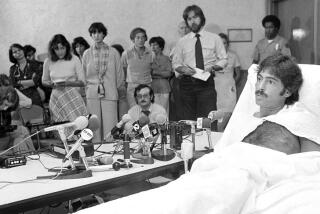Nearly Dies From Bite of Rare Snake : Venom Collector Gets a Taste of Own Medicine
- Share via
SALT LAKE CITY — When William Haast goes to his office each morning, 1,000 deadly snakes await him. By his count, he has given hundreds of thousands of snakes at least 2 million chances to kill him in the last 40 years.
One, a Pakistani viper, nearly succeeded a few weeks ago when it sprang from its gold-painted box cage and bit Haast on the left thumb.
Within 24 hours he was near death, and efforts to save his life created a stir in Iran and at the White House as his friends searched the globe for a serum.
That Haast had been bitten, never mind close to death, would have surprised anyone who saw him back in his laboratory two days after he left the hospital. Writhing furiously in his hands, with fangs bared, was a 10-foot diamondback rattlesnake.
With his left hand still swollen from the viper bite, Haast handled the rattler with agility that belied his 78 years.
Grabbing the rattler behind its head, Haast guided its mouth toward a plastic funnel covered with a white rubber sheath. As the serpent struck the sheath, Haast held its head down and watched as amber fluid poured from its fangs into a test tube below.
Venom Collector
The procedure is risky, but it is one of few ways Haast can obtain the venom he has spent more than half his life collecting. He sells the venom to universities and pharmaceutical companies for its medicinal value in treating polio, multiple sclerosis and arthritis. A professed “snake-aholic” since age 5, Haast founded the Miami Serpentarium Laboratories in 1948 and still serves as its director, although he moved from Florida to Salt Lake City nearly five years ago. He has been bitten by poisonous snakes 148 times, three times by deadly king cobras.
Haast said he can survive bites that would kill others because of weekly injections of venom he has given himself since 1948. They “have made me immune to the toxins in the venom,” he said. By injecting small amounts of diluted venom taken from many species, Haast has developed a reservoir of antibodies.
Without this built-in protection, Haast said, he would have to rely on serum extracted from the blood of horses injected with snake venom. The serum, containing horse antibodies, is called antivenin.
When the viper struck Haast’s thumb instead of the test tube, Haast had not yet protected himself against its poison. With characteristic nonchalance, he decided to wait a day to see what would happen.
“At about noon the next day,” said Nancy Harrell, assistant director of the laboratory, “he started bleeding profusely. The hospital . . . found that the venom had destroyed the clotting factor in his blood. . . . In essence, he became a hemophiliac.”
Haast, who in 1976 received a presidential commendation for donating his blood to save the lives of 21 snakebite victims, suddenly was in danger of bleeding to death, and the search for antivenin was begun. Harrell learned that Iran was one of the few sources of the type of antivenin he needed.
Rejection Letters
Before beginning his work with the Pakistani viper, Haast had attempted to obtain the antivenin from the Razi Institute, a vaccine and serum supplier in Hessarak, Iran. He received two letters of rejection. The stamp on one letter depicts an Iranian airliner being blown out of the sky by the USS Vincennes.
Allen Glanville, a business associate of Haast, established a command center in his Ogden office to seek overseas help. He enlisted the help of his son-in-law and an Iranian restaurateur (who asked that his name not be used). He also called Stephen Studdert, an acquaintance from Salt Lake City who is a special assistant to President Bush, to see if the White House could intercede with Iran.
“They told me that, as far as Iran was concerned, I couldn’t have picked a worse place,” Glanville said. “They said they had no contact there and probably couldn’t do anything, but they said they’d try.” Haast describes what happened next as “hands across the world.”
Two days after Haast was bitten, the restaurateur called his brother in Tehran and asked him to pick up the antivenin at the Razi Institute, two hours outside the city. The institute director had agreed to release it after he was told it would be used to treat an Iranian doctor in West Germany. “My brother . . . heard that someone was dying, and he just did it,” the restaurateur said.
An arrangement made through the State Department for an Iranian woman to carry the serum out of the country fell through, but the brother “finally found an employee from Lufthansa airlines, who agreed to carry it on the plane,” said Glanville. Meanwhile, he had located a few vials of antivenin at the English National Poison Unit in London and had them flown to the United States.
‘Invaluable Assistance’
The White House, he said, provided “invaluable assistance” in cutting the red tape involved in transporting the serum. The sera arrived from Tehran and London four days after Haast was bitten, but the serum from Tehran was never used.
More to Read
Sign up for Essential California
The most important California stories and recommendations in your inbox every morning.
You may occasionally receive promotional content from the Los Angeles Times.













